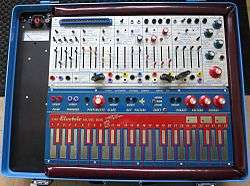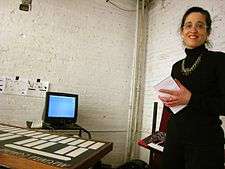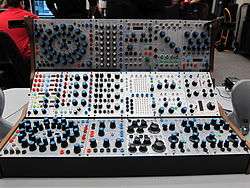Buchla Electronic Musical Instruments

_%40_nordcafe%2C_Teknisca_Museet.jpg)
Buchla Electronic Musical Instruments is a manufacturer of synthesizers and unique MIDI controllers. The company was founded as Buchla & Associates by synthesizer pioneer Don Buchla in 1963 in Berkeley, California.
Company origin
Buchla's first modular electronic music system was the result of a San Francisco Tape Music Center commission by composers Ramon Sender and Morton Subotnick in 1963, who later allotted $500 from a Rockefeller Foundation grant to Buchla in 1964. Subotnick envisioned a voltage-controlled instrument that would allow musicians and composers to create sounds suited to their own specifications. Previously, one had to use either discrete audio generators, such as test oscillators—or musique concrète, recorded sounds from natural sources. Buchla designed the synthesizer in a modular fashion, combining separate components that each generated or modified a music event. Each box served a specific function: envelope generators, oscillators, filters, voltage controlled amplifiers, and analog sequencer modules. Utilizing the different modules, a composer could affect the pitch, timbre, amplitude, and spatial location of the sound. The instrument was controlled and played via an array of touch and pressure-sensitive surfaces.[1]
The instrument was named the "Buchla 100 series Modular Electronic Music System," and was installed at the San Francisco Tape Music Center in 1965 and moved to Mills College in 1966. Subotnick completed his first major electronic work, Silver Apples Of The Moon, with another unit that Buchla had built and shipped to New York. This same unit was also used on Buffy Sainte Marie's influential 1969 album, Illuminations.[2] Along with Robert Moog's Moog synthesizer, it helped revolutionize the way electronic music and sound is made.
Products
Buchla 100 series (1960s)
The original Buchla modular synthesizer, originally commissioned by Morton Subotnick and Ramon Sender and funded by a grant from the Rockefeller Foundation. The earliest modules have no company name on the front panel, or are labeled "San Francisco Tape Music Center." Later modules were offered through the musical instruments division of CBS.
Buchla 200 series (1970)
The Buchla 200 series Electric Music Box[3] replaced the previous model in 1970 and represented a significant advance in technology. Almost every parameter can be controlled from an external control voltage.
Computer-controlled instruments
Buchla 300, 500, Touché (mid 1970s)
In the mid 1970s, Don Buchla began experimenting with digital designs and computer-controlled systems. The results were the 500 series[4] and the 300 series,[5] both of which paired the new technology with existing 200 series modules to create hybrid analog/digital systems. The Touché[6] was also the result of this research, and was also his final attempt to market a "mainstream" Buchla synth.
Buchla 400, 700, and MIDAS (1980s)
Also in 1980s, Buchla released the 400 series[7] and the 700 series[8] software controlled instruments operated by MIDAS, a Forth language for musical instruments, and also equipped with MIDI.

Buchla's unique synthesizer designs
Buchla tended to not refer to his instruments as synthesizers, as he felt that name gives the impression of imitating existing sounds/instruments. His intent was to make instruments that create new sounds. This goal is evident in the omission of a standard musical keyboard on his early instruments, which instead used a series of touch plates that were not necessarily tied to equal-tempered tuning.
He also used a different naming convention than most of the industry. For example, one of his modules is called a "Multiple Arbitrary Function Generator." These differences run deeper than nomenclature though. The Multiple Arbitrary Function Generator (or MARF) goes well beyond what a typical sequencer is capable of performing and is capable of acting as an envelope generator, LFO, CV selector, voltage quantizer or tracking generator.
Buchla's instruments, such as the Music Easel (pictured),[9] use a different method of timbre generation than Moog synthesizers. Moog units use oscillators with basic function generator type waveshapes and rely heavily on filtering with 24 dB resonant low-pass filters, while Buchlas are geared toward complex oscillators using frequency modulation, amplitude modulation, and dynamic waveshaping to produce other forms of timbre modulation. Many of Don Buchla's designs, including the Low-Pass Gates (later called Dynamic Managers) contain vactrols, photoresistive opto-isolator employed as voltage-controlled potentiometers, which contribute to a very "natural" Buchla sound.
MIDI controllers (late 1980s)
Buchla Thunder, Buchla Lightning, Marimba Lumina
By the late 1980s, Don Buchla had stopped creating instruments and shifted his focus to alternate MIDI controllers. His controller designs have included the Thunder,[10] Lightning,[11] and Marimba Lumina.[12]
Buchla 200e series (2004)
Finally, in 2004, Don Buchla returned to designing full blown modular electronic instruments with the 200e, a hybrid system using digital microprocessors that uses the same size modules and signals as the 100 and 200 series systems. The 200e modules convert all signals to analog at the panel, appearing to the user like an analog system, with patch cables. Systems can be built using a combination of 100, 200 and 200e modules. The 200e modules connect through a digital communications bus, allowing the system to store the settings of the knobs and switches.[13]
At the January 2012 NAMM show, Buchla & Associates announced new ownership, retaining Don Buchla as Chief Technology Officer and investment in the design, manufacturing, and marketing of Buchla products and the development of an expanded product line, and the company moving forward under the name Buchla Electronic Musical Instruments (BEMI).[14] One year later, BEMI re-introduced the Music Easel.[15] Since then, BEMI has released a small number of new modules, including the 252e Polyphonic Rhythm Generator. The "200h" series of modules (h = half) were also released to allow Buchla system owners to configure their systems in more granular ways.
Current status
In 2015, various websites, including FACT,[16] reported that Don Buchla had taken the owners of BEMI to court, citing health problems due in part to unpaid consulting fees and asserting a claim to his original intellectual property.
The court ordered the case to be settled outside court by Arbitration.
In 2016, BEMI and Don Buchla amicably settled all issues prior to Arbitration proceedings.
Buchla passed away on September 14, 2016.
Gallery
 Buchla Marimba Lumina on LEMUR
Buchla Marimba Lumina on LEMUR Buchla 200e (rear) with
Buchla 200e (rear) with
223e Tactile Input Port (front).jpg) Earliest analog sequencers on Buchla 100 (array of knobs on the bottom)
Earliest analog sequencers on Buchla 100 (array of knobs on the bottom)
See also
References
Notes
- ↑ Vail, Mark. Vintage Synthesizers, Miller Freeman Books, 1993, p. 97-99
- ↑ Gordon, Theodore (January 14, 2016). "Unboxing the Buchla Model 100". Library of Congress. Retrieved September 18, 2016.
- ↑ "The Electric Music Box - Buchla Series 200". Buchla and Associates.
- ↑ "Buchla 500 electronic musical instrument (photograph only)". Buchla and Associates.
- ↑ "Buchla Series 300 - digital control for 200 series module". Buchla and Associates.
- ↑ "Buchla Touche Introduction (front page)". Buchla and Associates.
- ↑ "Buchla 400 Product Information". Buchla and Associates.
- ↑ "Buchla 700 (front page)". Buchla and Associates.
- ↑ "Music Easel - Summary Description / December, 1973". Buchla and Associates.
- ↑ "Buchla Thunder". Buchla and Associates.
- ↑ "Buchla Lightning II". Buchla and Associates.
- ↑ "Marimba Lumina 2.5". Buchla and Associates.
- ↑ "Buchla Series 200e (front page)". Buchla and Associates. Archived from the original on 2009-04-12.
- ↑ "Buchla Electronic Musical Instruments Debuts At Winter NAMM 2012", Keyboard Magazine (January 2012)
- ↑ Robair, Gino. "NAMM 2013 Gino's Hits", Electronic Musician, (January 2013)
- ↑ http://www.factmag.com/2015/03/25/don-buchla-audio-supermarket-buchla-electronic-musical-instruments-lawsuit/
External links
| Wikimedia Commons has media related to |
- Buchla & Associates homepage
- Buchla & Associates - Historical Systems Overview
- Buchla Current Model 200e page
- Buchla 200 Series Information/Photos
- Buchla 100 Modular Synthesizer @ Synthmuseum.com
- Buchla instrument collection @ Audities.org

